British and European Car Spotters Guide - 1956 |
|
|
 |
|
|
|
During 1956 many prophets of doom were forecasting that British Motor Industry exports would never be as high as they had been in 1955. Criticisms levelled at the industry inncluded: obsolete design, poor finish, unreliability, and inefficient after-sales service and spare parts organization. As it turned out the year was probably the toughest on record in the post-war era for British manufacturers, with a credit squeeze, a clamp down on car imports by the major markets of Australia and New Zealand, and serious labour disputes. Added to this was the rapid growth of strong foreign competition.
Against this rather depressing background British manufacturers were instituting vast expansion plans-aimed not only at increassing production but also at reducing prices-and the reorganizaation of service and sales operations, while dismissing their critics as being over pessimistic. On the design front the larger manufacturers were increasingly adopting tubular tires as standard equipment, overdrive and automatic transmission systems were gaining in popularity and more and more manufacturers were offering de luxe equipment-in the form of optional extras-as a means of turning standard production cars into more luxurious models. New models during the year tended to come from the major companies, namely the Sunbeam Rapier, the Jaguar 2.4, the Standard Vanguard Phase III and the MGA. The year's total car production was 747,922 units. Exports accounted for 335,397 cars and UK registrations for 412,525 (including hackneys). |
 |
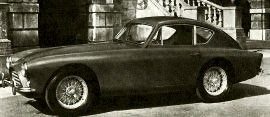 |
 |
AC Ace |
| |
Also see: AC Car Reviews | The History of AC (AUS Edition) |
| |
The AC Aceca Hard-top Coupe alternative to the Ace open model, both models were continued with no material changes but the Aceca now featured front and rear bumpers. It had similar basic specifications to the Ace, except that the differential was rubber-mounted. the instrument panel was different and it was longer. wider. higher and heavier. From April 1956 both models were also available with the Bristol 2-liter engine. |
|
 |
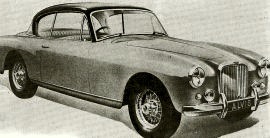 |
 |
Alvis TC108/G two-door Sports Saloon |
| |
Also see: Alvis Car Reviews | The History of Alvis |
| |
The Alvis TC108/G two-door Sports Saloon featured coachwork by G raber of Berne, Switzerland. The car had a 3-liter six-cylinder 104-bhp engine. independent front suspension with wishbones and coil springs. and semiielliptic leaf rear springs. The cleanly designed elegant body included straight-through wings. wrapround rear window and a curved bonnet. sloping down to a traditional Alvis radiator grille. The TC21-100 Grey Lady 3-liter Saloon was disscontinued in February 1956. |
|
 |
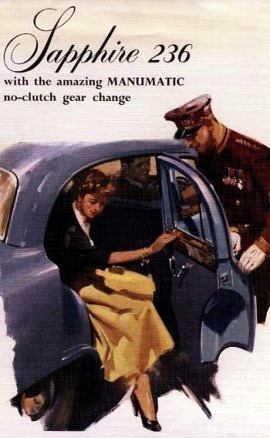 |
 |
Armstrong Siddeley Sapphire 236 |
| |
Also see: The History of Armstrong Siddeley |
| |
The Armstrong Siddeley Sapphire 234 and 236 Saloons followed in the wake of the successful 3½-liter Sapphire (renamed Sapphire 346). These two smaller models shared a completely new body and chassis but had different engines - four-cylinder, 2290-cc (234) and six-cylinder, 2309cc (236) - plus various other differences. The body featured deep windows and a bonnet line that sloped sharply down to a traditional type radiator grille. |
|
 |
 |
 |
Armstrong Siddeley Sapphire 346 Estate |
| |
Also see: The History of Armstrong Siddeley |
| |
The Armstrong Siddeley Sapphire 346 Estate was a rare model based on the Mark II Limousine chassis. This impressive vehicle had an overall length of 17 ft 8 in and 11 ft 1 in wheelbase. |
|
 |
 |
 |
|
| |
Also see: Aston Martin Car Reviews | The History of Aston Martin |
| |
The Aston Martin DB2-4 Mark II Sports Saloon was facelifted for 1955 and was distinguished from the Mark I by the different rear wing line incorporating modified lighting and signalling units, a front-hinged bonnet which no longer included the side panels, and chrome side strips. Also available were drophead coupe and hard-top versions. These two were discontinued in the autumn of 1956. |
|
 |
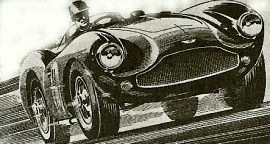 |
 |
Aston Martin DB3S Competition |
| |
Also see: Aston Martin Car Reviews | The History of Aston Martin |
| |
The Aston Martin DB3S Competition model which, from May 1956, was available to special order with fixed-head coupe bodywork. It featured curving wings and fluting on the side of the bonnet nose above the mesh grille. The 3-liter engine developed 210 bhp at 6000 rpm. It came first at the 1956 Le Mans in the 3 liter class (2,000cc - 3,000cc), the winning car being driven by Stirling Moss and Peter Collins, and having an average speed of 104.04 m.p.h. and aggregate of 2497.05 miles. |
|
 |
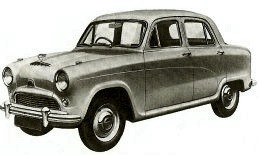 |
 |
Austin A50 Model HS5 Cambridge Saloon |
| |
Also see: Austin Car Reviews | The History of Austin (AUS Edition) |
| |
The Austin A50 (Model HS5) Cambridge Saloon continued with the addition of amber flashing trafficators This four-door model had the same body shell as the A40 (Model GS5) Saloon but with a four-cylinder 1489cc engine and different gearbox ratios. Also offered was a Countryman (Model HP5) estate car version, to special order only. |
|
 |
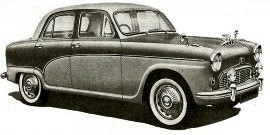 |
 |
Austin A105 Model BS5 Saloon |
| |
Also see: Austin Car Reviews | The History of Austin (AUS Edition) |
| |
The Austin A105 (Model BS5) Saloon was introduced in the spring of 1956. It featured a six-cylinder 2639-cc twin-carburetor engined and had the same basic body as the A90 Westminster. |
|
 |
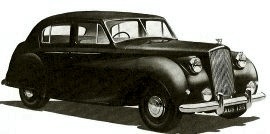 |
 |
Austin A135 four-light Touring Limousine Mark III version Model DM5 |
| |
Also see: Austin Car Reviews | The History of Austin (AUS Edition) |
| |
The Austin A135 four-light Touring Limousine Mark III version (Model DM5) was continued for 1956 - identified by built-in combined sidelamps and flashing trafficators on the wings above the front bumper. The engine was a 3993cc OHV Six Also available were a Saloon (DS5) and a long-wheelbase Saloon (DS6) and Limousine (DM4). |
|
 |
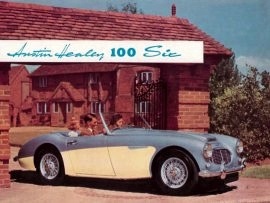 |
|
 |
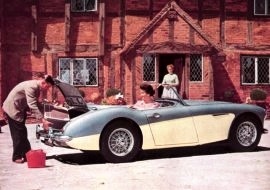 |
|
 |
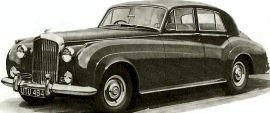 |
 |
Bentley S-Series Saloon |
| |
Also see: Bentley Car Reviews | The History of Bentley |
| |
The Bentley S-Series Saloon was introduced in the spring of 1955. This elegant model featured a 4887-cc (95 x 114 mm) engine with a six-port cylinder head, a new all-metal lightweight body and automatic transmission as standard. Wheelbase was 10ft 3 in. Power steering and a refrigeration unit were available at extra cost. |
|
 |
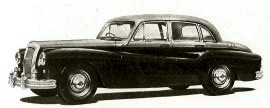 |
 |
Daimler One-O-Four Saloon |
| |
Also see: Daimler Car Reviews | The History of Daimler (AUS Edition) |
| |
The Daimler One-O-Four Saloon was a 3½-liter engined model (4½-liter also available) which replaced the Regency Mark 11. Engine performance was greatly increased-137 bhp compared with 107 bhp on the Regency. Also available was a Lady's Model version which featured, as standard, many items found only on specialized coachbuilt models, including power-operated windows, a radio, set of suitcases and picnic case in the luggage locker, telescopic umbrella, shooting stick and vanity case.
|
|
 |
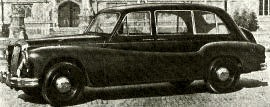 |
 |
Daimler DK400 Limousine |
| |
Also see: Daimler Car Reviews | The History of Daimler (AUS Edition) |
| |
The Daimler DK400 Limousine was a well-proportioned eight-seater which was 18 ft 1 in long, 6 ft 4 in wide and 5 ft 9¾ in high and fitted with a six-cylinder 4617cc power unit, preselector gearbox. vacuum servo-assisted brakes and a luxurious interior. |
|
 |
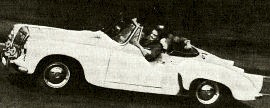 |
 |
Daimler Conquest Drophead Coupe |
| |
Also see: Daimler Car Reviews | The History of Daimler (AUS Edition) |
| |
The Daimler Conquest Drophead Coupe replaced the Conquest Roadster for 1956. It featured similar bodywork, with an occasional rear seat, and was powered by the 2433-cc 100-bhp engine. Conquest and Century Mark II 2½-liter saloons were also available, although the former was discontinued in the summer of 1956. |
|
 |
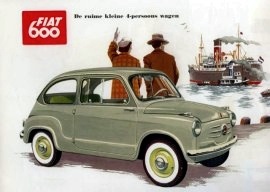 |
|
 |
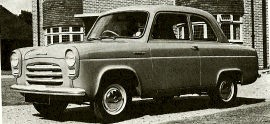 |
 |
Ford Anglia 100E Saloon De Luxe |
| |
Also see: Ford UK Car Reviews | The History of Ford |
| |
The Ford Anglia 100E Saloon was continued with detail modifications including separate amber flashing trafficators and, on the new De Luxe versions, chrome body-side strips, headlamp surrounds and window surrounds, a flat facia and improved seating. The full-width flush-sided body featured two doors and a horizontal-bar grille whereas the companion Prefect model had four doors and a vertical-bar grille. Both models were powered by the old 1172-cc 36-bhp side-valve Four engine. |
|
 |
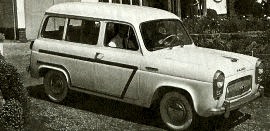 |
 |
Ford Squire and Escort 100E |
| |
Also see: Ford UK Car Reviews | The History of Ford |
| |
The Ford Squire and Escort 100E made their debut in the autumn of 1955 for the 1956 model year Based on the Prefect and Anglia respectively, these compact little estate cars were mechanically similar to the saloons. except that a different gearbox was used and the rear suspension modified. The Squire was to the more comprehensive specification-on a par with the Prefect-and featured wooden strips on the body sides, dual windtone horns. opening (sliding) side windows and better interior finish. |
|
 |
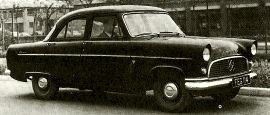 |
 |
Ford Consul Mark II Diesel Saloon |
| |
Also see: Ford UK Car Reviews | The History of Ford |
| |
Shown is a diesel-engined version of the Ford Consul Mark II Saloon, powered by a Perkins Four 99 engine. This model was distinguishable by the Perkins motif on the radiator grille. |
|
 |
 |
 |
|
| |
Also see: Ford UK Car Reviews | The History of Ford |
| |
The Ford Consul, Zephyr and Zodiac Saloons (right to left). These new Mark II versions were introduced early in 1956 and shared a completely new full six-seater body shape although each version had its own distinctive radiator grille and styling features. There were numerous mechanical modifications including increased engine performance and revised suspension and brakes. The cheaper and least powerful of the three-the Consul 204E-had a 1703-cc four-cylinder engine whereas the Zephyr and Zodiac 206E had 2553-cc six-cylinder engines. The Zodiac was the more expensive version and included additional trim and fittings Note the high roof line; this was changed in 1959 Clow-line models') |
|
 |
 |
 |
Frazer-Nash Sebring |
| |
Also see: The History of Frazer-Nash |
| |
The Frazer-Nash Le Mans Coupe was powered by the 1971-cc engine with a 9·0:1 compression ratio and an output of 140 bhp at 5750 rpm. This two-door two-seater-first introduced late in 1953 had similar general lines to the Sebring. All Frazer-Nashes were hand-built and very much tailored to meet individual owner's requirements. |
|
 |
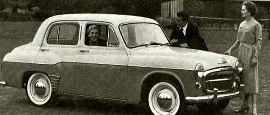 |
 |
Hillman Minx Series I |
| |
Also see: Hillman Car Reviews | The History of Hillman (AUS Edition) |
| |
The Hillman Minx Series I models were introduced in the spring of 1956 and featured new bodystyling-raised wing line, sloping bonnet and wrapround rear window-a longer and narrower radiator grille and a modified instrument panel and improved interior. Special Saloon, De Luxe Saloon and Convertible models were available. The Minx Estate Car was continued in its Mark VIII form, until May 1957. |
|
 |
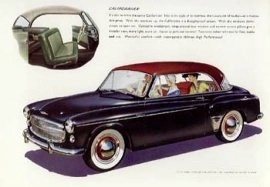 |
|
 |
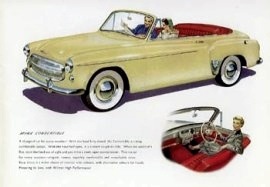 |
|
 |
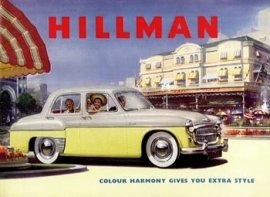 |
 |
Hillman Minx Phase VIIIA |
| |
Also see: Hillman Car Reviews | The History of Hillman (AUS Edition) |
| |
The Hillman Minx Mark VIllA De Luxe Saloon with new 'Gay Look' two-tone finish, body chrome strip and full-width tapered fairing housing the rear number plate. Convertible, Californian and Estate Car versions were also available with 'Gay Look' features. Both the Special Saloon and the Estate Car were now also powered by the OHV engine. Standard (single-colour) models retained the designation Mark VIII. |
|
 |
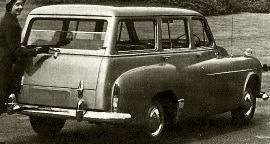 |
 |
Humber Hawk Estate |
| |
Also see: Hillman Car Reviews | The History of Hillman (AUS Edition) |
| |
The Humber Hawk Estate was mechanically identical to the Hawk Mark VI Saloon this smart six-seater four-door model featured rear seats that could be folded down to give a spacious luggage platformmarticles up to 7 ft long could be carried with the rear door panel let down to the platform position. It was introduced in October of the previous year. In April 1956 a De Luxe version of the Saloon made its appearance, designated Hawk Mark VIA.
|
|
 |
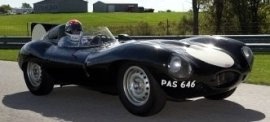 |
|
 |
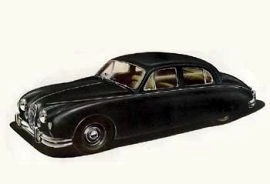 |
 |
Jaguar Mark 1 2.4 liter |
| |
Also see: Jaguar Car Reviews | Jaguar - A Racing Pedigree | The History of Jaguar |
| |
The Jaguar 2·4-liter Saloon was a highly successful four-door sports saloon was introduced in the autumn of 1955 and featured a full-width body which was unmistakably Jaguar but with more compact dimensions than previous saloons. Horn grilles were located either side of the XK140-type radiator grille. The 2·4-liter (83 x 76·5 mm) 112-bhp engine (25B) was the latest developpment of the famous six cylinder twin-carburetor double-OHC XK unit. Wheelbase was 8 ft 11 3/8in, overall length 15ft ¾ in, width 5 ft 6¾ in. Tyre size was 640-15. |
|
 |
 |
 |
Land-Rover Series I Regular 86 |
| |
Also see: Land Rover Car Reviews | The History of Rover (AUS Edition) |
| |
The Land-Rover Series I Regular 86 in its standard form with canvas tilt, as produced during 1953-56. It was available also with hard-top. Station Wagons were supplied on this Regular 86 chassis (from 1954), as well as on the 107-inch long-wheelbase chassis (from 1955), the latter model featuring two doors on each side and ten seats. In June 1956 the 86-in wheelbase Regular models received modifications to front wings and bonnet. and their wheelbase was increased to 88 inches.
|
|
 |
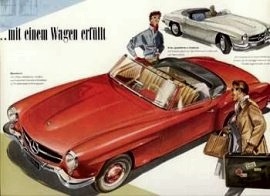 |
|
 |
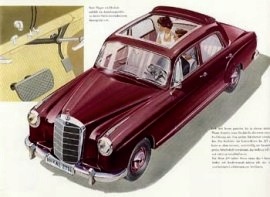 |
|
 |
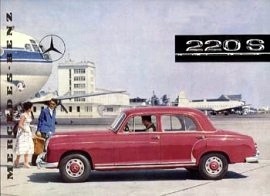 |
|
 |
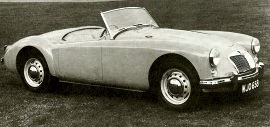 |
 |
MG Model MGA Sports |
| |
Also see: MG Car Reviews | The MG Story | The History of MG |
| |
The MG Model MGA Sports was a direct development of the prototype known as the EX182 which did so well in the 1955 Le Mans 24-hour race. This new two-seater was a complete breakaway from the traditional MG sports cars and featured a full-width body with sloping bonnet and grille. air outlet grilles on top of the scuttle and separately-styled rear wings. The 1489-cc fourrcylinder engine had an 8·3:1 compression ratio and an output of 68 bhp at 5500 rpm. |
|
 |
 |
 |
Morgan Plus Four Series II Tourer |
| |
Also see: Morgan Car Reviews | The History of Morgan |
| |
The Morgan Four-Four Series II Tourer. This new lower-priced twooseater sported a body similar to the Plus Four but had a flat-back panel with a protruding petrol filler cap next to the semi- recessed spare wheel. Power came from a Ford 1172cc four-cylinder engine which developed 36 bhp at 4400 rpm.
|
|
 |
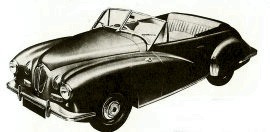 |
 |
Paramount 1½-liter Sports |
| |
|
| |
The Paramount 1½-liter Sports was the successor to the Ten Roadster (from 1950). This model was available with Tourer and Sports Saloon body styles, and was powered by a 1508-cc 47-bhp engine with three-speed gearbox and featured light-alloy four-seater bodywork. Paramount Cars (Leighton Buzzard) Ltd continued small-scale prooduction, but demand dwindled and soon the entire stock was taken over by Welbeck Motors Ltd of London who sold off the remaining cars at something like £220 less than the original list price. |
|
 |
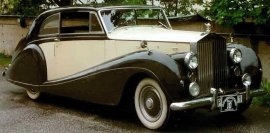 |
 |
|
| |
Also see: Rolls-Royce Car Reviews | The History of Rolls-Royce |
| |
The RolIs-Royce Silver Wraith continued with a larger engine - 4887cc v. 4566cc - anti-roll bar at front. and automatic transmission as standard. Shown is a seven-passenger Limousine, bodied by H. J. Mulliner (Design No. 7358). |
|
 |
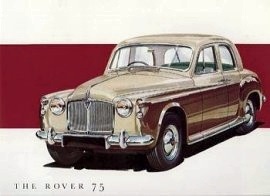 |
|
 |
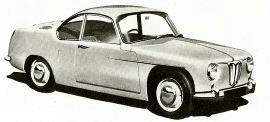 |
 |
Rover T3 Coupe Gas Turbine Experimental |
| |
Also see: Rover Car Reviews | The History of Rover (AUS Edition) |
| |
The Rover T3 Coupe was a revolutionary experimental car powered by a gas-turbine. The 110-bhp power unit was mounted at the rear and developed from an industrial gas-turbine engine (1S/60) The glass-reinforced plastic body had a low bonnet line with a deep wrapround windscreen and large rear window. The T3 also had four-wheel drive - a desirable safety factor on a car that had such a high torque to weight ratio. |
|
 |
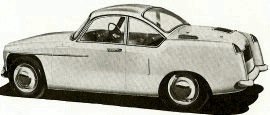 |
|
 |
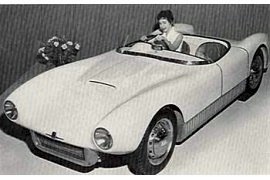 |
 |
Saab Prototype Sonet |
| |
Also see: Saab Car Reviews | The History of SAAB |
| |
The greatest sensation at the 1956 Stockholm Motorcar Show (with more than 400 different cars on show) was undoubtedly the Saab Sonett Super Sport, built by Saab's Motorcar Division at Trolhattan. An experimental car, the Saab Sonett Super Sport has been built mainly to enrichen Saab's experience in the design of advanced cars. As far as the chassis was concerned, the Saab Sonett was (nearly) based 100% on the standard Saab-93 chassis. The car was equipped with a Saab-93 engine, which was boosted to give 57.5 h.p. at 5.000 r.p.m. (as against 38 h.p. in the standard Saab-93 car). Max. torque was approx. 63 lbs.ft. (9 kpm) at 3,500 r.p.m. |
|
 |
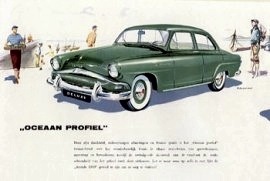 |
|
 |
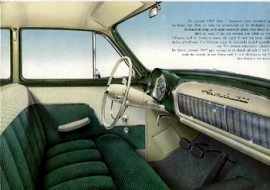 |
|
 |
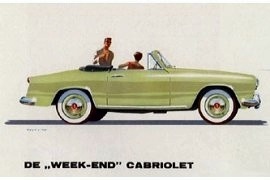 |
|
 |
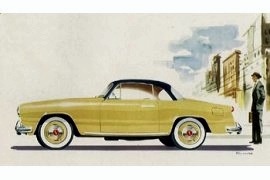 |
|
 |
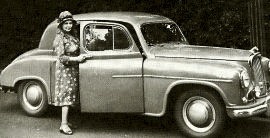 |
 |
Singer Hunter Saloon De Luxe |
| |
Also see: Singer Car Reviews | The History of Singer |
| |
The Singer Hunter Saloon De Luxe as produced during March-August 1956, and featured a wooden facia, spring-loaded boot lid and other refinements. Also offered (from September 1955) was an economy version, designated Hunter S, which had a painted radiator grille without the horse's head mascot and no fog lamps. chrome strips or arm rests. |
|
 |
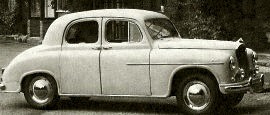 |
 |
Singer Hunter 75 |
| |
Also see: Singer Car Reviews | The History of Singer |
| |
The Singer Hunter 75 was a more powerful version, equipped with a twin overhead-camshaft version of the 1497-cc engine, producing 75 bhp at 5250 rpm. It first appeared in October 1955 and had twin Solex downdraught carburetors, 8·0:1 compression ratio, stronger clutch, divided propeller shaft and larger brakes. The front seats could be adjusted for height and tilt as well as fore-and-aft movement. Few were made, however, and the Hunter range was discontinued in the summer of 1956. shortly after Singer Motors Ltd were absorbed into the Rootes Group. |
|
 |
 |
 |
Standard Ten Companion |
| |
Also see: Standard Car Reviews | The History of Standard |
| |
The Standard Ten Companion was based on the Super Ten. This estate variant had four side loars and double rear doors. The front seats were separately adjustable, while the rear bench seat could be folded forward to give a flat load carrying pace. Maximum carrying capacity was 448 lb. |
|
 |
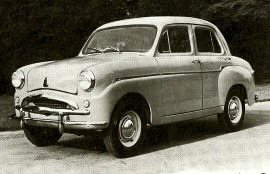 |
 |
Standard Super Ten |
| |
Also see: Standard Car Reviews | The History of Standard |
| |
The Standard Super Ten was introduced in the autumn of 1955. This was a better equipped version of the basic Ten. A Super Eight and a Family Ten (early in 1956) were also introduced. |
|
 |
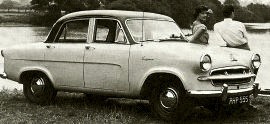 |
 |
|
| |
Also see: Standard Car Reviews |
| |
The Standard Vanguard Phase III Saloon was entirely new for 1956, except for engine and gearbox. This four-light model featured a lower, longer and lighter body which was integral with the chassis, a curved single-piece windscreen and wrap-aound rear window. The 2088-cc engine produced 68 bhp. |
|
 |
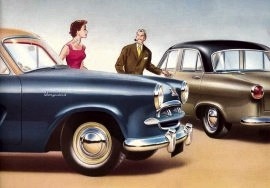 |
 |
|
| |
Also see: Standard Car Reviews | The History of Standard |
| |
The new Phase III Vanguard of 1955 (pictured left)
finally broke away from the old "separate" chassis
engineering layout of the two previous Vanguard models.
The new chassis arrangement also allowed the engine
to sit further forward in the body, thus allowing improved
interior space. |
|
 |
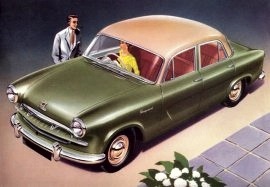 |
 |
|
| |
Also see: Standard Car Reviews | The History of Standard |
| |
The Vanguard III also featured revised, modern styling
which benefited from a much lower roofline than the
older car. The lower roof and unitary construction all
helped save weight and improve the cars performance
and fuel consumption. The 2088cc Vanguard engine carried
over from the earlier model along with the gearbox (although
with higher ratios) but was now offered with an optional
overdrive unit. 37194 phase III Vanguards were manufactured. |
|
 |
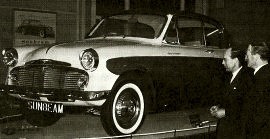 |
 |
Sunbeam Rapier Series I Hard-top Saloon |
| |
Also see: Sunbeam Car Reviews | The History of Sunbeam |
| |
The Sunbeam Rapier Series I Hard-top Saloon was unlike any previous Sunbeam, and featured full-width bodywork incorporating a wide and distinctive radiator grille. The car had a 1390-cc 62-bhp (gross) engine, four-speed gearbox with Laycock overdrive and two-colour body finish, all as standard equipment. Shown is the first Rapier to be shipped to Northern Ireland. |
|
 |
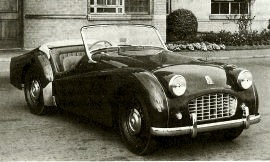 |
 |
Triumph TR3 Sports |
| |
Also see: Triumph Car Reviews | The History of Triumph |
| |
The Triumph TR3 Sports was the more powerful successor to the 1953-55 TR2. This popular version had larger twin carburetors which increased the power output from 90 to 95 bhp; it was later increased to 100 bhp, following cylinder head modifications Externally it was distinguishable from the TR2 by a honeycomb grille over the air intake, and scuttle vents. An occasional rear seat was available. |
|
 |
 |
 |
Turner 803 Sports |
| |
|
| |
Following successes with a number of sports/ racing and competition models, Turner Sports Cars (Wolverhampton) Ltd put the two-seater Turner 803 Sport into small-scale production towards the end of 1955. It was fitted with Austin A30 engine, gearbox, rear axle and front suspension, and featured a smooth, flush-sided open body made of fiberglass, with inner steel panels. Its economical engine and light bodywork resulted in very good fuel consumption figures. |
|
 |
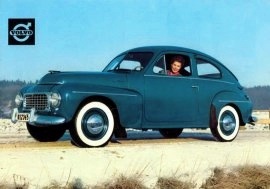 |
 |
|
| |
Also see: Volvo Car Reviews | The History of Volvo |
| |
In 1955 the PV 444 received extensive face-lift treatment, the most obvious being the one-piece rear window and enlarged windscreen. The tail lights were moved from the mudguards to the sides of the car. |
|
 |
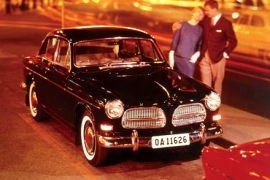 |
 |
Volvo Amazon |
| |
Also see: Volvo Car Reviews | The History of Volvo |
| |
One of the first cars specifically developed with safety as a key part of the package. Pioneered items such as padded dashboards and three-point seatbelts, and was a successful rally car, too. |
|
 |
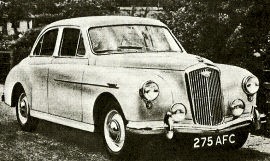 |
 |
Wolseley Fifteen-Fifty Saloon |
| |
Also see: Wolseley Car Reviews | The History of Wolseley (AUS Edition) |
| |
The Wolseley Fifteen-Fifty Saloon was the replacement for the Four Forty-Four, this four-cylinder 1½-liter-engined model featured a body very similar to that of the MG Magnette, which sold for the same price, although one was easily distinguished from the other, mainly by the traditional radiator grilles and different rear windows The Fifteen-Fifty was introduced in June 1956. The six-cylinder-engined Six-Ninety Saloon was continued with minor changes and was now available with overdrive. |
|
|
